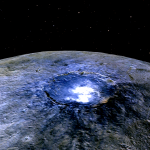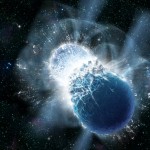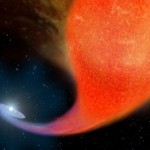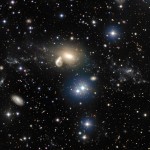C’è ammoniaca su Cerere
 È quanto rilevato dallo strumento VIR a bordo della sonda Dawn sulla superficie del pianeta nano Cerere. La presenza di ammoniaca è un dato di fondamentale importanza per lo studio della storia evolutiva di Cerere. «La scoperta potrebbe confermare alcune teorie sulla migrazione dei pianeti nelle fasi primordiali del sistema solare», secondo Maria Cristina De Sanctis, INAF – IAPS, primo autore dell'articolo pubblicato da Nature Continue reading
È quanto rilevato dallo strumento VIR a bordo della sonda Dawn sulla superficie del pianeta nano Cerere. La presenza di ammoniaca è un dato di fondamentale importanza per lo studio della storia evolutiva di Cerere. «La scoperta potrebbe confermare alcune teorie sulla migrazione dei pianeti nelle fasi primordiali del sistema solare», secondo Maria Cristina De Sanctis, INAF – IAPS, primo autore dell'articolo pubblicato da Nature Continue reading
Save the particles
To learn more about the particles they collide, physicists turn their attention to a less destructive type of collision in the LHC.

Every second, the Large Hadron Collider generates millions of particle collisions. Scientists watching these interactions usually look out for only the most spectacular ones.
But recently they’ve also taken an interest in some gentler moments, during which the accelerated particles interact with photons, quanta of light.
When charged particles—like the protons the LHC usually collides or the lead ions it is colliding right now—are forced around bends in an accelerator, they lose energy in the form of light radiation.
Originally, physicists perceived this photon leak as a nuisance. But today, laboratories around the world specifically build accelerators to produce it. They can use this high-energy light to take high-speed images of materials and processes in the tiniest detail.
Scientists are now using the LHC as a kind of light source to figure out what’s going on inside the protons and ions they collide.
The LHC’s accelerated particles are chock-full of energy. When protons collide—or, more specifically, when the quarks and gluons that make up protons interact—their energy is converted into mass with manifests as other particles, such as Higgs bosons.
Those particles decay back into energy as they sail through particle detectors set up around the collision points, leaving their signatures behind. Physicists usually study these particles, the ones created in collisions.
In proton-photon collisions, however, they can study the protons themselves. That’s because photons can traverse a particle’s core without rupturing its structure. They pass harmlessly through the proton, creating new particles along the way.
“When a high-energy light wave hits a proton, it produces particles—all kinds of particles—without breaking the proton,” says Daniel Tapia Takaki, an assistant professor at the University of Kansas who is a part of the CMS collaboration. “These particles are recorded by our detector and allow us to reconstruct an unprecedentedly high-quality picture of what’s inside.”
Tapia Takaki is interested in using these photon-induced interactions to study the density of gluons inside high-energy protons and nuclei.
As a proton is accelerated to close to the speed of light, its gluons swell and eventually split—like cells dividing in an embryo. Scientists want to know: Just how packed are gluons inside these protons? And what can that tell us about what happens when they collide?
The Standard Model—a well-vetted model that predicts the properties of subatomic particles—predicts that the density of gluons inside a proton is directly related to the likelihood a proton will spit out a pair of charm quarks in the form of a J/psi particle during a proton-photon interaction.
“So by measuring the J/psi’s production rate very precisely, we can automatically have access to the density of gluons,” Tapia Takaki says.
Prior to joining the CMS experiment, Tapia Takaki worked with colleagues on the ALICE experiment to conduct a similar study of photon-lead interactions. Tapia Takaki plans to study the lead ions currently being collided in the LHC in more detail with his current team.
The trickiest part of these studies isn’t applying the equation, but identifying the collisions, Tapia Takaki says.
To identify subtle proton-photon and photon-lead collisions, Tapia Takaki and his colleagues must carefully program their experiments to cherry-pick and record events in which there’s no evidence of protons colliding—yet there is still evidence of the production of low-energy particles.
“It’s challenging because the interactions of light with protons or lead ions take place all the time,” Tapia Takaki says. “We had to find a way to record these events without overloading the detector’s bandwidth.”
L’origine degli elementi pesanti
 Numerosi dati mostrano che la quantità osservata in natura di plutonio-244 è molto superiore a quanto atteso dai modelli. Un team di ricercatori dell’Università Ebraica di Gerusalemme ha proposto che questo eccesso sia prodotto dalla fusione di stelle di neutroni in sistemi binari Continue reading
Numerosi dati mostrano che la quantità osservata in natura di plutonio-244 è molto superiore a quanto atteso dai modelli. Un team di ricercatori dell’Università Ebraica di Gerusalemme ha proposto che questo eccesso sia prodotto dalla fusione di stelle di neutroni in sistemi binari Continue reading
Il segreto delle stelle rinate
 Osservazioni dell’ammasso stellare aperto NGC 188 hanno permesso ad un gruppo di astronomi dell’Università del Texas di studiare in dettaglio la particolare evoluzione di una classe di oggetti stellari noti come blu-straggler. I risultati di questo studio, pubblicato su ApJ, pongono dei limiti alla percentuale di blu-straggler che si sono formate attraverso il meccanismo del trasferimento di massa Continue reading
Osservazioni dell’ammasso stellare aperto NGC 188 hanno permesso ad un gruppo di astronomi dell’Università del Texas di studiare in dettaglio la particolare evoluzione di una classe di oggetti stellari noti come blu-straggler. I risultati di questo studio, pubblicato su ApJ, pongono dei limiti alla percentuale di blu-straggler che si sono formate attraverso il meccanismo del trasferimento di massa Continue reading
Collisione cosmica in differita
 Questo oggetto fornisce agli astronomi un'eccellente opportunità di capire meglio questo tipo di galassie, che ci si aspetta siano comuni nell'Universo primordiale ma troppo deboli e distanti per essere osservate con gli odierni telescopi Continue reading
Questo oggetto fornisce agli astronomi un'eccellente opportunità di capire meglio questo tipo di galassie, che ci si aspetta siano comuni nell'Universo primordiale ma troppo deboli e distanti per essere osservate con gli odierni telescopi Continue reading
Man made Cleverness: Could it At any time Have a Place of a persons Imagination?
Man made Cleverness: Could it At any time Have a Place of a persons Imagination?
Advent
Man made cleverness happens to be an chance that need stop assumed in any really serious contemplating relating to the upcoming considering that it mounts many weighty challenges for open public and values insurance coverage an feature that philosophers should commence pondering.http://get-essay.com/term-paper Artificial intelligence denotes the knowledge exhibited by software programs and systems. Manufactured intellect is a analysis rotating all around the structure and prepare of smart agents. Continue reading

